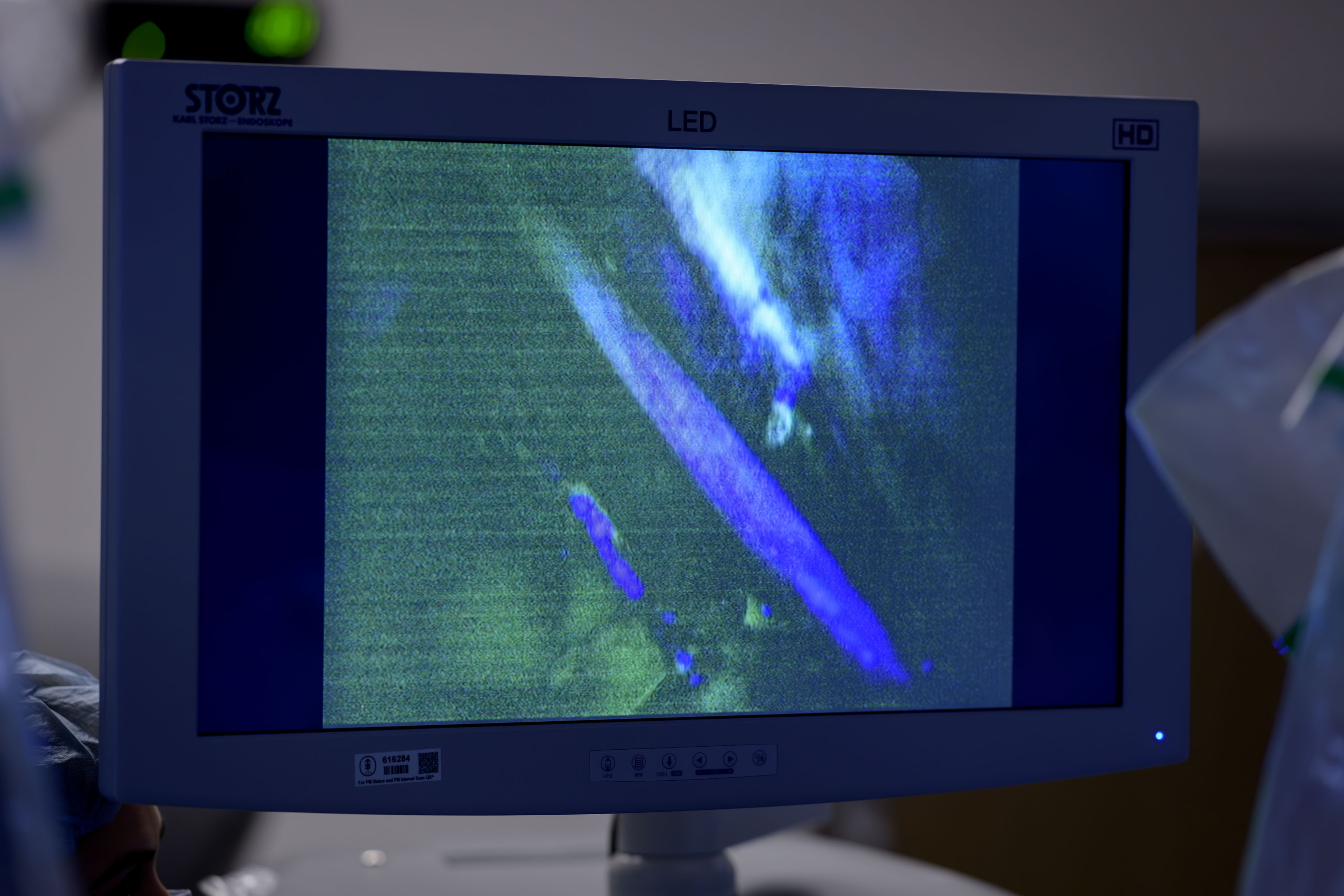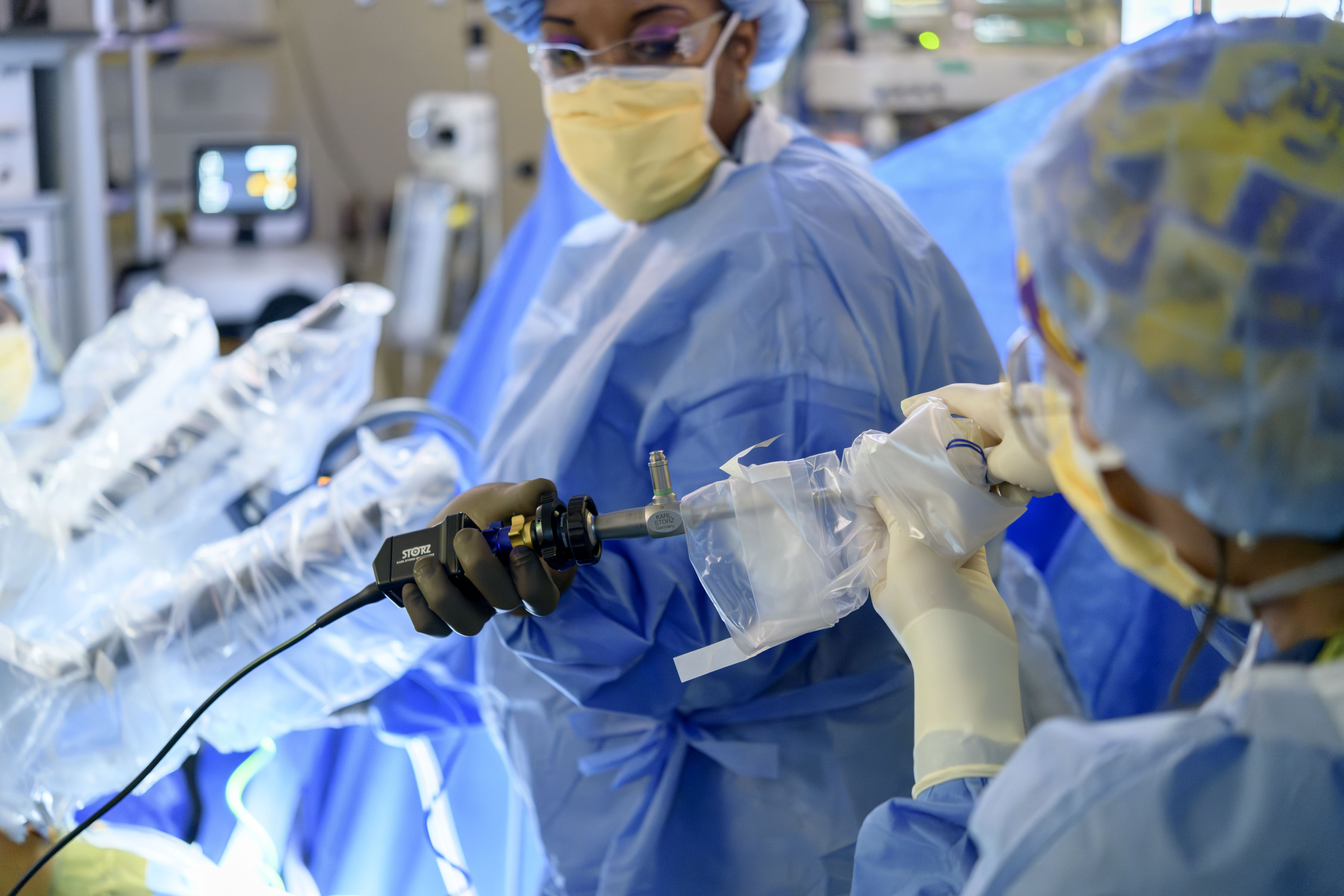
MSK surgeon Dr. Timothy Donahue says the new imaging technology could potentially help prevent nerve damage in a range of operations.
Men having prostate cancer surgery often fear side effects that can result from the procedure. These include urinary leakage and erectile dysfunction caused by harm to nerves when the tumor is removed. Now a new way to light up nerves during the operation may help surgeons avoid this damage, preserving the patient’s quality of life.
The new technology uses a fluorescent imaging agent called Illuminare-1, which binds to myelin, an insulating sheath around the nerves. When doctors shine a special blue light on the surgical area, the agent glows and increases the visibility of the nerves.
Memorial Sloan Kettering Cancer Center (MSK) researchers are testing Illuminare-1 in a phase 1 clinical trial in patients undergoing prostate cancer surgery. At the 2024 Annual Meeting of the American Urological Association held May 3-6, results from the first 28 patients to receive the agent demonstrated it to be safe and effective, with minimal complications.
“This imaging approach could provide a huge benefit to men needing prostate cancer surgery,” says urologic surgeon Timothy Donahue, MD, who is leading the phase 1 trial. “We have urgently needed a better way to see nerves during procedures. We’re very excited about the potential of this technology, not just for prostate cancer surgery but possibly many other operations.”
Illuminare-1 was developed through a collaboration between MSK, General Electric, and Illuminare Biotechnologies.
Nerve Imaging Tested in Prostate Cancer Surgery Clinical Trial
The standard surgery for people with prostate cancer is radical prostatectomy, a complex operation that removes the entire prostate gland along with some surrounding structures. It can be difficult for surgeons to see the nerves, especially when they are positioned close to other structures.

The fluorescent agent Illuminare-1 lights up the obturator nerve in the pelvis under blue light imaging. Surgeons use the nerve as a reference for sufficient nerve illumination before proceeding with the prostate surgery.
In the MSK clinical trial, patients receive Illuminare-1 by intravenous infusion early in the operation. Within a short time, the nerves are fully illuminated. They remain brightened throughout the radical prostatectomy, which typically takes two to three hours. The body clears the fluorescent agent naturally within about a day, so there are no lingering effects.
The MSK trial enrolled its first patient in January 2023. The study, which is still open, will ultimately enroll up to 50 patients to help establish the agent’s safety as well as allow doctors to determine the best dose level.
Benefits of MSK Clinical Trials for Improving Treatment
Dr. Donahue says excitement has grown as more patients enroll.
“The big challenge with a phase 1 study like this is the first patient,” Dr. Donahue says. “They rightfully ask, ‘How many people have you done this on before?’ ”

Urologic oncology fellow Dr. Maria Pere (right) and physician assistant Lolita Simmons placing the blue light optical filter on the scope prior to visualization of the illuminated nerves.
The first patient who signed up for the study was someone whose daughter had joined a trial for pediatric cancer at MSK years before.
“He had an appreciation for what clinical trials can offer and the innovations that come from them,” Dr. Donahue says. “I’m always grateful to him because he kind of broke the seal and helped bring in the next wave of patients.”
Dr. Donahue credits MSK’s extensive team of experts in drug development for helping shepherd the drug into clinical trials.
“Illuminare-1 would never have been developed as quickly as this without the infrastructure at MSK,” he says. “Now that we have a phase 1 study in progress — and it appears to be safe — we are getting a lot of interest from companies that could support further trials.”
Illuminare-1 Has Potential To Improve Range of Surgeries
While the initial testing is in prostate cancer surgeries, Dr. Donahue and colleagues are thinking about how to expand its use to other cancers, such as surgery for head and neck cancer, gastric cancer, colorectal cancer, and breast cancer — including reconstruction. Future trials might include non-cancer-related procedures, like hand surgery.
“It takes several years for nerve function to recover after radical prostatectomy, so you have to wait a long time to see if this treatment is effective at reducing damage,” he explains. “But if this agent was used for something like carpal tunnel surgery, you could get answers much sooner — like assessing hand grip strength after a month.”
Dr. Donahue believes that intraoperative imaging will transform surgery, making it both more effective and easier on patients. The pace of imaging technology is advancing rapidly.
“What was available just five years ago pales in comparison to what we can use now,” Dr. Donahue says. “This is going to become part of how we operate in the future.”





